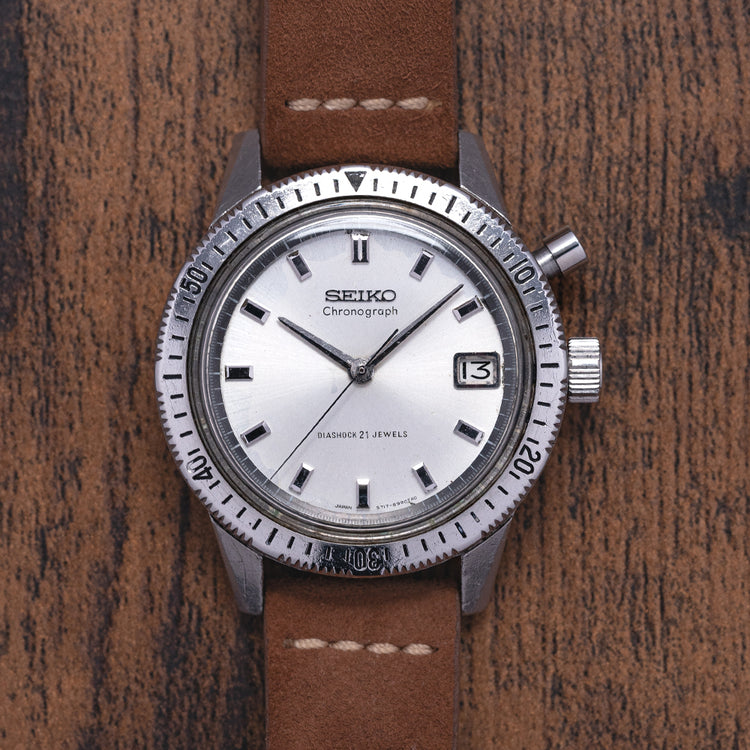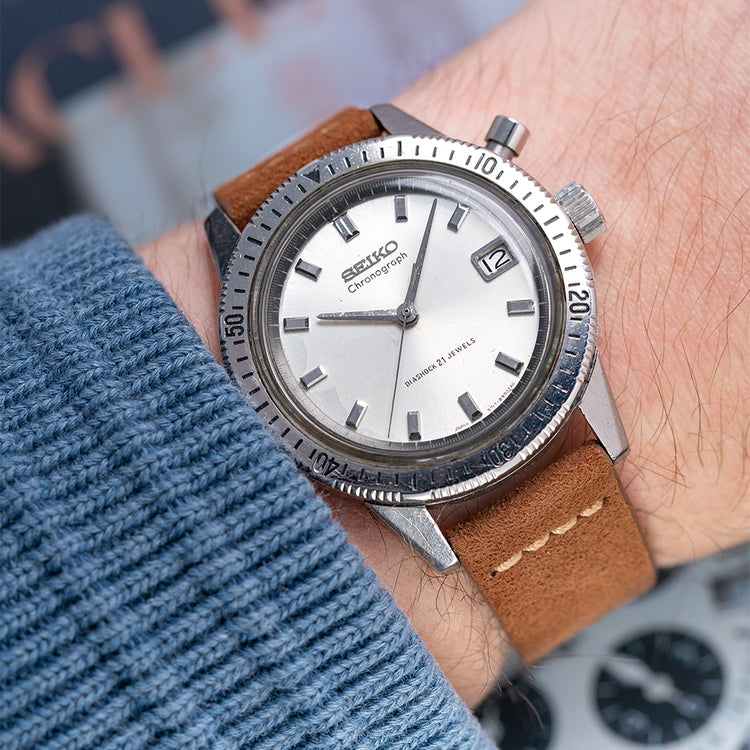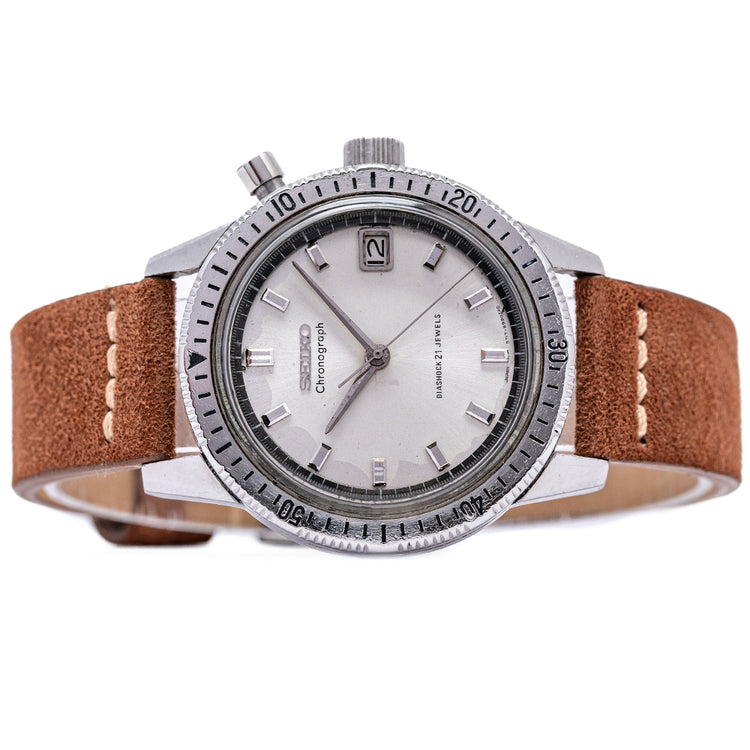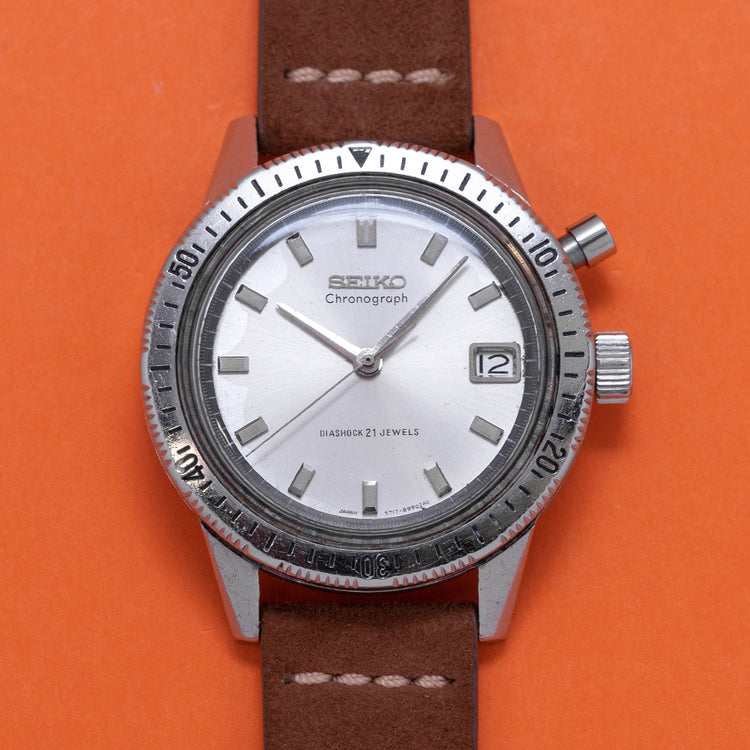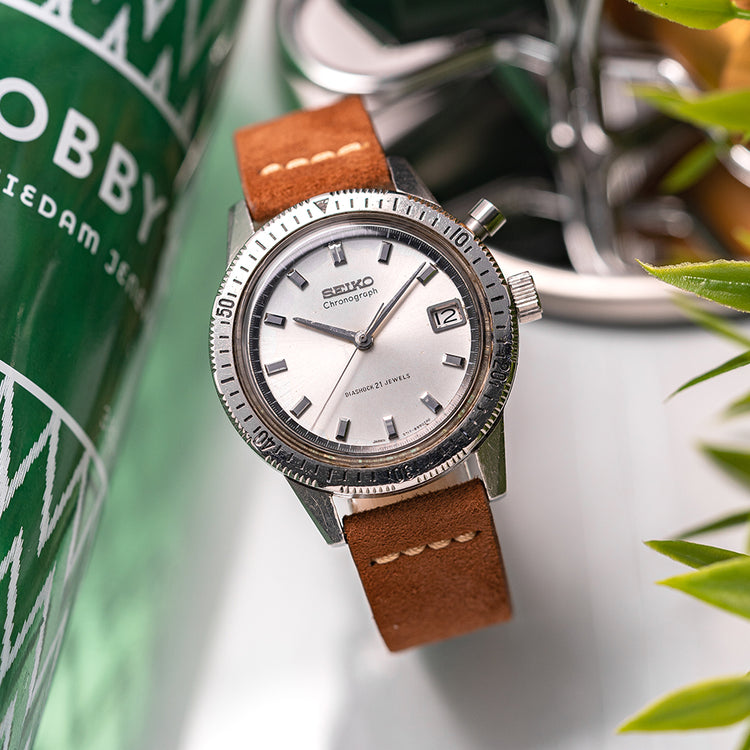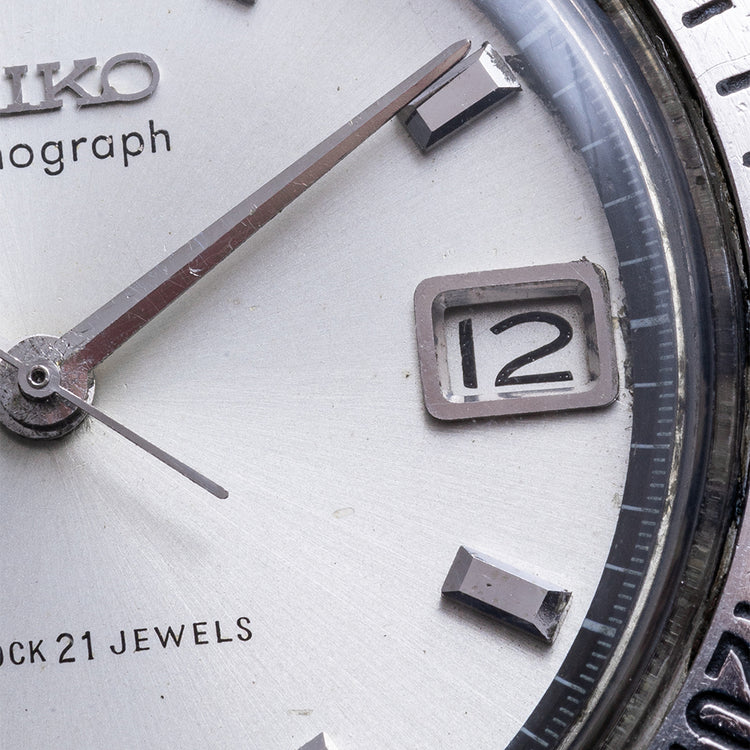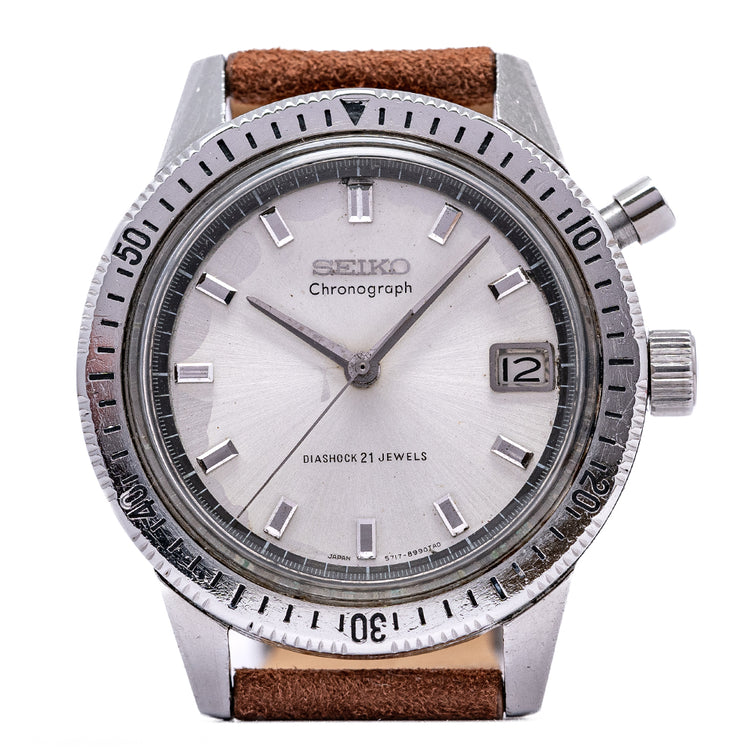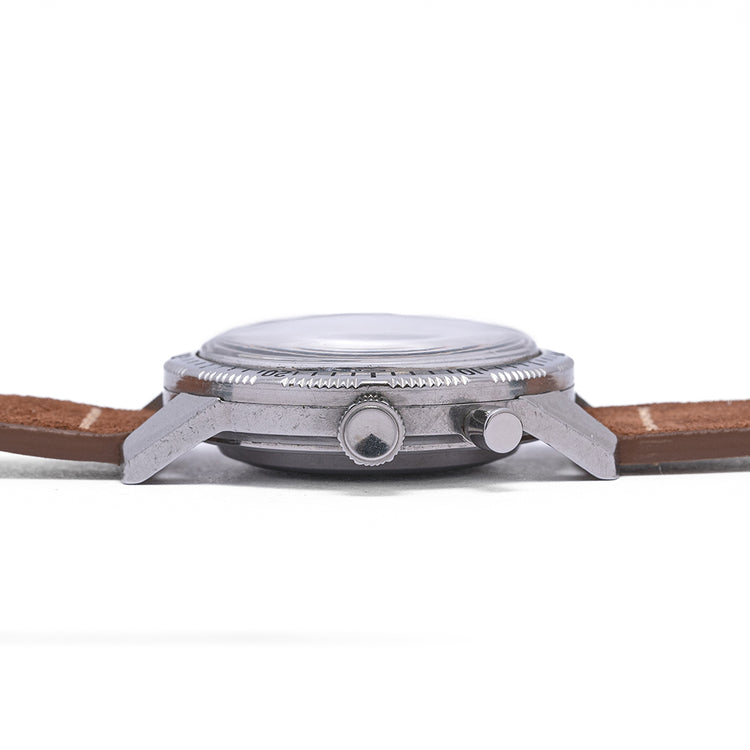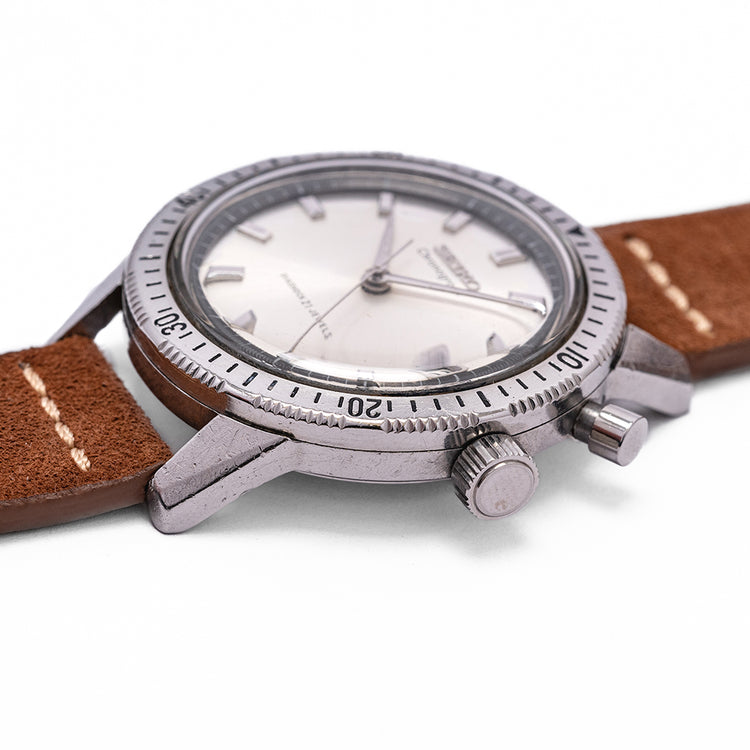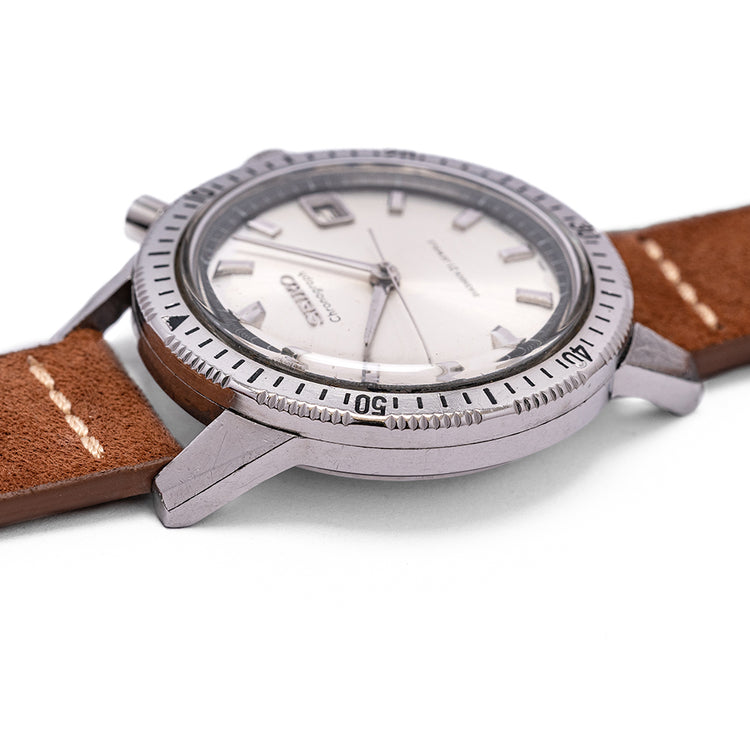More Information
Description
More
Less
The Watch
Here we have a 1965 Seiko Mono-pusher Chronograph Ref. 5717-8990, which was first produced in 1964 for the 18th Tokyo Olympics. Suwa Seikosha developed their first chronograph wristwatch as a status symbol as well as a timing device, they are affectionately known as the “Seiko Chronostop” as it functions similarly to the Omega Chronostop. Seiko was the official timekeeper of those games. Its 37mm round stainless steel case has brushed and polished surfaces, a lug-to-lug length of 44.5mm and a case thickness of 11mm ensuring a comfortable fit on your wrist. On the right side a single pusher at 2 o’clock and a large crown, making adjustments a breeze. The stainless steel bi-directional bezel has a 60-minute scale etched into it. A domed crystal sits above a sunburst silver dial, an outer minute track is clearly printed and applied baton indexes have chamfered edges that catch the light as you turn your wrist at 3 o’clock a framed date window. Thin steel hands hit their mark perfectly, and delicate tapered steel chronograph hand hits the mark perfectly. On the reverse, a screw-down case back with the Seiko Seahorse engraved in the centre, underneath the serial number, that includes the month and year of production. Inside a Manually Wound Seiko Cal. 5717, 21 jewels, 18,000 beats per hour with horizontal coupling and a column wheel to control the single pusher that does all three functions start, stop and reset to zero. The watch comes fitted on an 18mm suede strap.
Points of Mention
This watch is sold as "Watch Only" and therefore comes with no original Seiko box or paperwork. The watch comes paired with an 18mm suede strap. The watch is from Circa. January 1965 and is in worn vintage condition, but overall fair as you can see, some marks to the outer dial can be seen. The watch comes with our 12-Months NON-Waterproof Warranty.
Personal Note
I have been fortunate to have sold a few 5717-8990, still the nicest references from Seiko! If you have been looking for a great example of this reference, don't sleep on this one, pull the trigger before it's too late!
Specification
Lugs : 18mm
Condition : Pre-Owned
Box & Papers : None
Case Material : Stainless Steel
Warranty : 12-Months NON-Waterproof Warranty
The Brand
Seikos' history began in 1881 when Kintaro Hattori established the K. Hattori retail and repair store. In 1892 Seikosha was established by making wall clocks. 1895 saw the production of their first pocket watch. 1913 saw the launch of their first wristwatch, the Laurel. In 1924 the first Seiko was manufactured. Daini Seikosha (now Seiko Instruments Inc.) was established in 1937. Seiko was listed on the Tokyo stock exchange in 1949. The Suwa factory became independent and formed Suwa Seikosha Co., Ltd. (now Seiko Epson Corporation in 1959). In 1956 Seiko launched Marvel as their first true in-house made watch; they continued to make this watch until 1959. Japan’s first chronograph watch was introduced for the 1964 Tokyo Olympics; it was called the Seiko Crown Chronograph monopusher. Not stopping there Seiko launched Japan's first true divers watch the Seiko Diver’s 150M fitted with the automatic Caliber 6217 which later was given the nickname “62MAS” by collectors. The company name was changed to the Seiko Corporation in 1990. Innovation at Seiko continues today with GPS Solar watches.
Points of Mention
More
Less
Personal Note
More
Less
Specification
More
Less
Movement : Manually Wound Seiko Cal. 5717
Year : 1965
Case Size : 37mm
Case Thickness : 11 mm
Lug to Lug : 44.5mm
Lugs : 18mm
Condition : Pre-Owned
Box and Papers : None
Case Material : Stainless Steel
Warranty : 12-Months NON-Waterproof Warranty
The wrist model's wrist size is 7inch
Description
The Watch
Here we have a 1965 Seiko Mono-pusher Chronograph Ref. 5717-8990, which was first produced in 1964 for the 18th Tokyo Olympics. Suwa Seikosha developed their first chronograph wristwatch as a status symbol as well as a timing device, they are affectionately known as the “Seiko Chronostop” as it functions similarly to the Omega Chronostop. Seiko was the official timekeeper of those games. Its 37mm round stainless steel case has brushed and polished surfaces, a lug-to-lug length of 44.5mm and a case thickness of 11mm ensuring a comfortable fit on your wrist. On the right side a single pusher at 2 o’clock and a large crown, making adjustments a breeze. The stainless steel bi-directional bezel has a 60-minute scale etched into it. A domed crystal sits above a sunburst silver dial, an outer minute track is clearly printed and applied baton indexes have chamfered edges that catch the light as you turn your wrist at 3 o’clock a framed date window. Thin steel hands hit their mark perfectly, and delicate tapered steel chronograph hand hits the mark perfectly. On the reverse, a screw-down case back with the Seiko Seahorse engraved in the centre, underneath the serial number, that includes the month and year of production. Inside a Manually Wound Seiko Cal. 5717, 21 jewels, 18,000 beats per hour with horizontal coupling and a column wheel to control the single pusher that does all three functions start, stop and reset to zero. The watch comes fitted on an 18mm suede strap.
Points of Mention
This watch is sold as "Watch Only" and therefore comes with no original Seiko box or paperwork. The watch comes paired with an 18mm suede strap. The watch is from Circa. January 1965 and is in worn vintage condition, but overall fair as you can see, some marks to the outer dial can be seen. The watch comes with our 12-Months NON-Waterproof Warranty.
Personal Note
I have been fortunate to have sold a few 5717-8990, still the nicest references from Seiko! If you have been looking for a great example of this reference, don't sleep on this one, pull the trigger before it's too late!
Specification
Lugs : 18mm
Condition : Pre-Owned
Box & Papers : None
Case Material : Stainless Steel
Warranty : 12-Months NON-Waterproof Warranty
The Brand
Seikos' history began in 1881 when Kintaro Hattori established the K. Hattori retail and repair store. In 1892 Seikosha was established by making wall clocks. 1895 saw the production of their first pocket watch. 1913 saw the launch of their first wristwatch, the Laurel. In 1924 the first Seiko was manufactured. Daini Seikosha (now Seiko Instruments Inc.) was established in 1937. Seiko was listed on the Tokyo stock exchange in 1949. The Suwa factory became independent and formed Suwa Seikosha Co., Ltd. (now Seiko Epson Corporation in 1959). In 1956 Seiko launched Marvel as their first true in-house made watch; they continued to make this watch until 1959. Japan’s first chronograph watch was introduced for the 1964 Tokyo Olympics; it was called the Seiko Crown Chronograph monopusher. Not stopping there Seiko launched Japan's first true divers watch the Seiko Diver’s 150M fitted with the automatic Caliber 6217 which later was given the nickname “62MAS” by collectors. The company name was changed to the Seiko Corporation in 1990. Innovation at Seiko continues today with GPS Solar watches.
Points of Mention
Personal Note
Specification
The Brand
Enquire or Book an Appointment
Would you like to discover further details about this watch, or perhaps arrange an appointment to view and try it on? Complete this form and a member of our team will get back to you shortly.
You May Also Like
































